When it comes to bicycle maintenance, one of the essential tasks is bike crankshaft removal. This process involves detaching the crankset from the bottom bracket of your bike, which allows you to clean, repair, or replace various components. In this guide, we’ll walk you through the process of bike crankshaft removal in a step-by-step manner, ensuring a smooth and hassle-free experience.
Step 1: Gather the Necessary Tools
Before you begin the bike crankshaft removal process, make sure you have the following tools on hand:
- Crank puller
- Allen wrenches (typically 5mm or 8mm)
- Adjustable wrench
Step 2: Remove the Crank Bolt or Nut
Start by removing the crank bolt or nut that secures the crank arm to the bottom bracket spindle. To do this, use the appropriate size Allen wrench or adjustable wrench.
Step 3: Insert the Crank Puller
Next, thread the crank puller into the crank arm hole where the bolt or nut was removed. Ensure the puller is fully engaged and securely in place to prevent damage to the crank arm threads.

Step 4: Detach the Crank Arm
Now, use the adjustable wrench to turn the crank puller’s handle clockwise. This action will force the crank arm away from the bottom bracket spindle. Once the crank arm is detached, unthread the crank puller.
Step 5: Repeat for the Other Side
Perform the same process on the opposite crank arm to complete the bike crankshaft removal.
Maintaining your bike’s crankshaft is essential for optimal performance, just as it is for automobiles. For instance, in vehicles, a properly functioning crankshaft position sensor is vital. To learn more about this component, check out our article on the 2006 Nissan Altima crankshaft position sensor.
Bicycle crankshafts differ from those found in vehicles, but their basic function is the same. If you are interested in learning more about crankshafts in general, visit crankshaft bike.
Lastly, if you are experiencing engine troubles in your vehicle, it could be due to a faulty crankshaft sensor. Read our article Engine Troubles? Detecting and Addressing Crankshaft Sensor Symptoms to discover how to detect and resolve such issues.
In conclusion, bike crankshaft removal is an essential skill for any cyclist who wants to perform routine maintenance or repairs. By following the steps outlined in this guide, you can ensure a smooth and efficient process, extending the lifespan of your bike and improving your overall cycling experience.